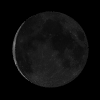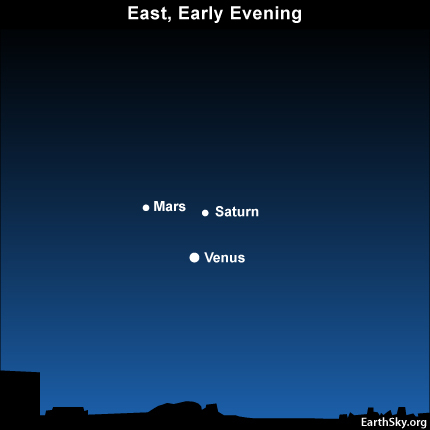Courtesy of EarthSky
A Clear Voice for Science
www.EarthSky.org [1]
 [2]
[2] [3]Around August 7 and 8, look in the west after sunset for the planets Venus, Mars and Saturn as they form what is known as a planetary trio.
[3]Around August 7 and 8, look in the west after sunset for the planets Venus, Mars and Saturn as they form what is known as a planetary trio.
Around August 7 and 8, look in the west after sunset for the planets Venus, Mars and Saturn as they form what is known as a planetary trio. A planetary trio is a grouping of three planets that fits inside a circle that is only 5 degrees wide. Typically, a binocular field spans about 5 degrees, so there is a good chance you will see all three planets in a single binocular field tonight.
To find tonight’s planetary trio, look westward at nightfall for the brightest point of light in the sky. That is Venus, outshining Mars and Saturn by leaps and bounds. Golden Saturn ranks as the trio’s second brightest light and Mars ranks third. If you have difficulty discerning planets or their colors, try binoculars!
Planetary trios are fairly rare. The last one occurred in February 2009 and the next one won’t be until May 2011. Enjoy the attraction while the time is at hand!
After the planetary trio sets at mid to late evening, look in the opposite direction to catch the blazing planet Jupiter over the eastern horizon. Jupiter will swing upward through the night and be high up in the northern hemisphere’s southern sky at dawn.
Looking for a sky almanac? EarthSky recommends . . . [4]
Written by Bruce McClure [5]
Typically, a binocular field spans about 5 degrees, so there is a good chance you will see all three planets in a single binocular field tonight.
To find tonight’s planetary trio, look westward at nightfall for the brightest point of light in the sky. That is Venus, outshining Mars and Saturn by leaps and bounds. Golden Saturn ranks as the trio’s second brightest light and Mars ranks third. If you have difficulty discerning planets or their colors, try binoculars!
Planetary trios are fairly rare. The last one occurred in February 2009 and the next one won’t be until May 2011. Enjoy the attraction while the time is at hand!
After the planetary trio sets at mid to late evening, look in the opposite direction to catch the blazing planet Jupiter over the eastern horizon. Jupiter will swing upward through the night and be high up in the northern hemisphere’s southern sky at dawn.
Looking for a sky almanac? EarthSky recommends . . . [4]
Written by Bruce McClure [5]
Astronomy Picture of the Day from NASA/JPL [6]
U.S. Naval Observator Astronomical Information cente [8]r
StarDate Online [9]
Sky and Telescope [10]
National Geographic [11]
Space Com [12]
Amazing Space [13]
The York County Astronomical Society [14]
Scope City [15]